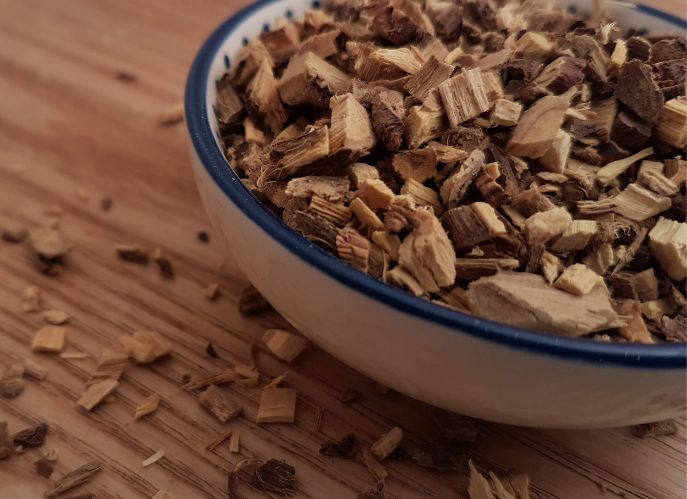Licorice root, derived from the Glycyrrhiza glabra plant, has a storied history as both a flavorful ingredient and a potent herbal remedy. Its use spans ancient civilizations, and today, it continues to find a place in traditional medicine and modern wellness practices.
In the annals of ancient Egypt, licorice root was transformed into a sweet drink fit for pharaohs. Across cultures, it played a vital role in traditional Chinese, Middle Eastern, and Greek medicines. Its applications were diverse: soothing upset stomachs, reducing inflammation, and treating upper respiratory issues. Fast-forward to the present, and licorice root remains relevant
Benefits of Licorice Root
Licorice root, derived from the plant Glycyrrhiza glabra, is a renowned herbal remedy with a storied history of use in traditional medicine systems across the world, from ancient Egypt to traditional Chinese medicine. Known for its sweet flavor, licorice root harbors an array of bioactive compounds, with glycyrrhizin standing out for its significant health-promoting properties. Let’s delve into the benefits of licorice root, backed by contemporary research and traditional practices.
Helps Improve Acid Reflux and Heartburn
- Key Components: Glycyrrhizin, the active compound in licorice root, exhibits antioxidant, anti-inflammatory, and antimicrobial properties. These features contribute to its effectiveness in managing gastrointestinal issues.
- Mechanism and Effects: Licorice root’s soothing properties on the gastrointestinal tract can help mitigate the symptoms of acid reflux and heartburn. It does so by enhancing mucus production in the stomach, providing a protective barrier against stomach acids and promoting the healing of gastric tissue. Some studies suggest that deglycyrrhizinated licorice (DGL), which has the glycyrrhizin removed to avoid potential side effects, is particularly effective for this purpose.
Treating Skin Conditions
- Bioactive Richness: Licorice root is abundant in over 300 compounds, showcasing potent anti-inflammatory, antibacterial, and antiviral effects. These properties make it an excellent remedy for various skin conditions.
- Applications: Its application extends to treating eczema, acne, and psoriasis, where its compounds can reduce redness, ease inflammation, and support the healing process. Licorice root is also employed in skin lightening treatments, as it contains liquiritin, a compound that disperses melanin and fades hyperpigmentation.
Promoting Digestive Comfort
- Traditional Use: For centuries, licorice root has been utilized to soothe upset stomachs and alleviate gastrointestinal discomfort, testament to its enduring efficacy in promoting digestive health.
- Supporting Digestion: The anti-inflammatory properties of licorice root make it a valuable ally against digestive inflammation, helping to soothe gastrointestinal tissues and relieve symptoms of conditions like gastritis and irritable bowel syndrome (IBS). Its role in increasing mucus production further aids in protecting the stomach lining and reducing gastric irritation.
Bolstering the Immune System
- Immune Enhancement: Glycyrrhizin plays a crucial role in enhancing the body’s immune response. By stimulating the activity of immune cells, licorice root helps the body fend off pathogens and infections more effectively.
- Broad-Spectrum Protection: Beyond its direct antimicrobial properties, licorice root also modulates the immune system, offering a twofold defense strategy against infections and diseases. This makes it a valuable tool in preventing colds, flu, and other viral infections, as well as in supporting overall immune health.
Additional Considerations and Precautions
While licorice root offers numerous health benefits, it’s essential to approach its use with caution due to potential side effects associated with glycyrrhizin, such as increased blood pressure and lowered potassium levels when consumed in large quantities or over prolonged periods. Opting for DGL supplements can mitigate these risks, allowing for the safe inclusion of licorice root in a health regimen.
Ways to Use Licorice Root

- Tea: Brew a cup of licorice root tea to soothe sore throats and promote digestive health.
- Topical Gels: Apply licorice root gels to address skin conditions like acne or eczema.
What are the side effects of Licorice root?
Licorice root, derived from the ‘Glycyrrhiza glabra’ or ‘Glycyrrhiza uralensis’ plant, has a long history of use in traditional Eastern and Western medicine. While it is generally considered safe for various health concerns, consuming too much can lead to potentially severe side effects
- Glycyrrhizin Buildup: The primary active ingredient in licorice root is ‘glycyrrhizin’. Excessive consumption can cause an abnormal increase in the stress hormone ‘cortisol’, leading to a severe imbalance in the body’s fluids and electrolytes.
- Blood Pressure and Potassium Levels: Licorice root can affect blood pressure and potassium levels. It’s essential to monitor these parameters, especially if you have existing health conditions.
Safety Considerations
Licorice root supplements are not regulated like drugs in the United States. Choose supplements tested by trusted third parties, but remember that even third-party testing doesn’t guarantee safety for everyone. Consult your healthcare provider before taking any supplements, considering potential interactions with other medications¹.
In summary, while it offers potential benefits, it’s crucial to be aware of its side effects and exercise caution when using it as a supplement.
References
https://www.verywellhealth.com/the-benefits-of-licorice-root-89727
https://www.webmd.com/vitamins/ai/ingredientmono-881/licorice



